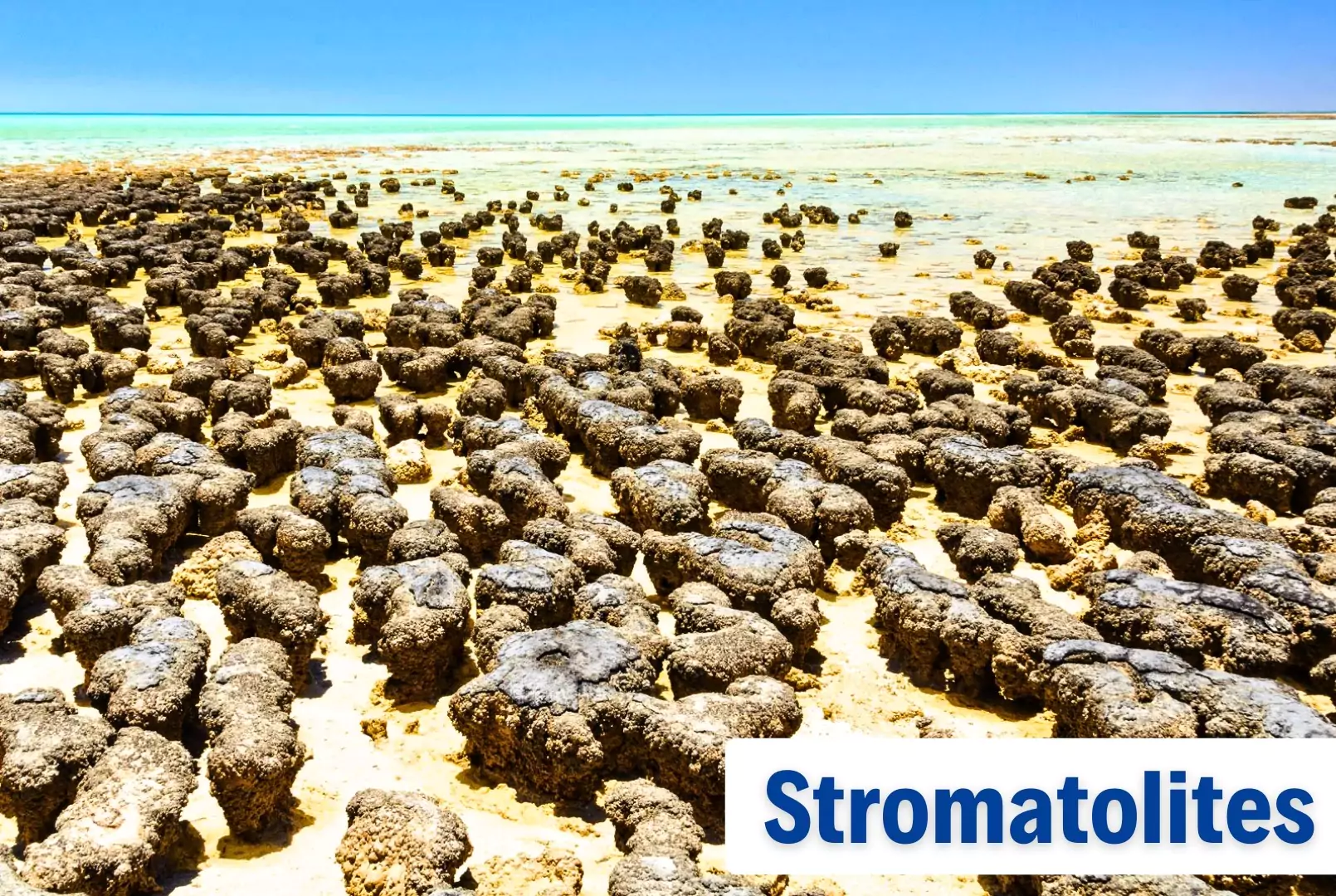The discovery of living stromatolites on Sheybarah Island in Saudi Arabia is a big step forward in understanding Earth’s ancient history and the development of life.
What are Stromatolites?
Stromatolites are layers of limestone formed mainly by blue-green algae growth. They have thin, alternating light and dark layers and come in flat, hummocky, or dome shapes.

- Origins: Stromatolites were prevalent during the Precambrian era, over 542 million years ago.
- While most stromatolites are marine, some dating back more than 2 ½ billion years from Proterozoic strata are believed to have formed in intertidal zones, freshwater ponds, and lakes.
- Formation: Stromatolite formation initiates with the growth of cyanobacteria on surfaces like rocks or sediment.
- As these microorganisms proliferate, they capture and bind sediment particles, accumulating organic material and minerals in layers.
- Gradually, these layers accumulate, resulting in the formation of characteristic dome-shaped or columnar structures.
- Habitation: Stromatolites flourish most in Shark Bay, Western Australia, where high salt levels caused by evaporation discourage snails and other organisms from eating the algae, aiding their growth.
Enroll now for UPSC Online Course
Great Oxygenation Event
Around 2.4 billion years ago, cyanobacteria emitted oxygen into Earth’s oceans, enriching them with oxygen. Over time, the oxygen began escaping into the atmosphere, interacting with methane.
- As oxygen release increased, methane was gradually displaced, and oxygen became a predominant component of the atmosphere.
- This significant transition in Earth’s atmospheric composition is known as the Great Oxidation Event.
|
- Role of Stromatolites: Stromatolites played a key role in the Great Oxygenation Event, significantly altering the Earth’s atmosphere by introducing oxygen.
- This oxygen initially eliminated competition for stromatolites, allowing them to dominate the Archean and early Proterozoic environments.
Significance of Stromatolites
- Insights into Early Life: Stromatolites offer direct evidence of ancient microbial communities, shedding light on Earth’s early biosphere.
- Environmental Reconstruction: They assist scientists in reconstructing past climates, ocean chemistry, and atmospheric conditions.
- Astrobiological Significance: The study of ancient stromatolites contributes to the search for potential life on other planets, such as Mars.
Stromatolite Deposits in India
- Vindhyan Supergroup (Central India): Rich in stromatolites, with some formations dating back 2.5 billion years.
- Bhima Basin (Karnataka): Various stromatolite formations providing insights into ancient ecosystems.
- Additional Sites: Rajasthan, Chhattisgarh, and the Himalayas also feature smaller stromatolite deposits.
Check Out Previous Years Papers From PW Store
About Sheybarah Island
- Environment of Sheybarah Island: Sheybarah Island features an intertidal to shallow subtidal environment.
- It is characterized by frequent shifts between wet and dry conditions, wide temperature fluctuations ranging from 8°C to over 48°C, and nutrient-poor conditions similar to those in the Bahamas.
- Diversity: The Sheybarah Island field comprises numerous stromatolites, ranging from fully developed textbook specimens to flat structures with minimal relief, potentially indicating early stages of formation.
Shark Bay
- About: Shark Bay, is a designated UNESCO World Heritage Site situated in the Gascoyne region of Western Australia.
- Natural Features: It has three exceptional natural features:
- It has vast sea-grass beds, which are the largest and richest in the world
- It has large dugong (‘sea cow’) population
- It has stromatolites (colonies of algae which form hard, dome-shaped deposits and are among the oldest forms of life on Earth).
|
![]() 6 Jun 2024
6 Jun 2024

